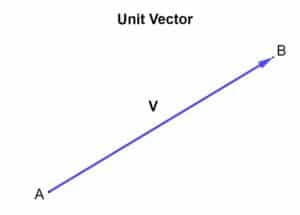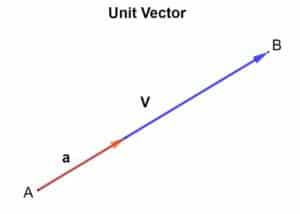Unit Vector – Explanation and Examples
 Just like in Physics, every measurable quantity has a measuring unit. Similarly, in vector geometry, every vector also has a measuring unit, which can be termed as a Unit Vector. In simpler words, a unit vector can be defined as:
Just like in Physics, every measurable quantity has a measuring unit. Similarly, in vector geometry, every vector also has a measuring unit, which can be termed as a Unit Vector. In simpler words, a unit vector can be defined as:
“Any vector with magnitude 1 can be described as a Unit Vector.”
In the topic of unit vectors, we will be covering the following topics:
- What is a Unit Vector?
- How to find a Unit Vector?
- How to find a Unit Vector in the same direction?
- What is the formula for Unit Vectors?
- What are the properties of a Unit Vector?
- Examples
- Practice problems
What Is A Unit Vector?
A unit vector is a vector whose magnitude is 1, or in mathematical terms, a unit. In vector geometry, the notation of a unit vector is slightly different. Unit vectors are denoted by placing a hat (^) on top of the vectors. The vector v shown in the figure below is a unit vector and can be represented by v^.

In mathematics and physics, we often come across the word ‘unit.’ But what exactly does it mean? If we dive into basic elementary mathematics, then the word ‘unit’ was defined in the very beginnings of mathematics. The word unit symbolizes ‘1’. The word ‘unit; was first encountered in the mathematics Place Value system. The foundation of the system was based on units as it symbolizes the ‘ones’ place.
Similarly, in the realm of vector geometry, the unit vector also stands for ‘1’. A unit vector is required to scale a vector. In the physics language, we can describe this scaling as measuring.
Unit vectors are basically units of a vector, and any vector can be represented in terms of the unit vector.
Since unit vectors have a magnitude of 1, the only information they provide regarding a vector is its direction. This is the reason why unit vectors are also called ‘Direction Vectors.’ When unit vectors are used to scale a vector, they provide us the direction of that particular vector.
For example, the vector v shown below has a magnitude of 3, but this vector can also be represented in terms of the unit vector a, whose magnitude is 1, but its direction is north-east.

Unit vectors are used to scale vectors in both two and three-dimension
Direction Of Unit Vectors
The unit vector of any vector v is bound to exist in the same direction as the vector v. This is because the unit vector of any vector acts as a measuring unit for the vector. Since the magnitude of the unit vector is already 1, so it’s only accounting for the direction of the vector v.
This is why the unit vector of any vector v exists in the same direction as the vector v. Just as the vector components are not real vectors that exist in a place. Similarly, a unit vector does not physically exist in the plane. Its sole purpose is to provide a measuring unit to any vector and provide the vector with a specific direction.
Whether a vector exists in a two-dimensional or a three-dimensional plane, the vector must have its corresponding unit vector. The same formula applies to find unit vectors in both two-dimensions and three-dimensions.
Direction Of Unit Vectors In Two-Dimensions
In the case of a two-dimensional plane, one component, the unit vector, is directed along the x-axis while the other is directed along the y-axis.
We are well aware that only the two axes, x, and y, exist in two-dimension. The unit vectors in two-dimension exist as follows:
Let’s consider a vector v, with magnitude 3, in two-dimension as shown in fig(1.2). This vector v can also be described in terms of the unit vectors, with unit vectors acting as the components of the vector v. This vector can also be written in terms of its unit vector components as follows:
v = 2x^ + 2.25y^
Direction Of Unit Vectors In Three-Dimensions
In three-dimensions, an additional axis is included, which is referred to as the z-axis.
Unit vectors in three-dimensions can be depicted as follows:
v = x^ + y^ + z^
Example 1
Determine which one among the 2 vectors is a unit vector
(i) v = 0.5x(^) + 0.86y(^) (ii) v = 2x^ + 3y^
Solution
For finding the unit vectors, we will find the magnitude of both these vectors:
Let’s first solve equation (i):
v = 0.5x^ + 0.86y^
|v| = √((0.5)^2 + (0.86)^2)
|v| = 0.99
|v| ≅ 1
So vector (i) is a unit vector.
Let’s see equation (ii):
v = 2x^ + 3y^
|v| = √((2)^2 + (3)^2)
|v| = 3.6
So vector (ii) is not a unit vector.
How To Find A Unit Vector?
As unit vectors are only known to specify the direction of any vector v, the unit vector of any vector v has the same direction as the vector v. Upon performing the necessary magnitude calculations on the determined unit vector, and it can be evident that the magnitude appears to be 1.
We have already discussed that any vector can be represented in terms of its unit vectors. Similarly, we can find a unit vector of any given vector having the same direction as the given vector.
Examples can strengthen this concept.
So in simpler words, we can conclude that every vector in either a two-dimensional or three-dimensional plane is bound to be accompanied by its unit vector responsible for depicting the direction of the vector.
Vectors can exist in both a two-dimensional and a three-dimensional plane. Similarly, their unit vectors can also exist in these planes. Each unit vector exists along a particular axis, whether be x,y, or z, and is perpendicular to the remaining axes.
Formula For Finding Unit Vectors
For any vector v, its corresponding measuring unit, which is its unit vector, exists in the direction parallel to the vector v and has a magnitude of 1. This unit vector can be found by applying the following formula:
Unit vector = vector / vector’s magnitude
u = v / |v|
The unit vector can also be denoted by u.
We can summarize finding the unit vector into 4 basic steps:
- Note the vector v with the given components along each axis.
- Find the magnitude of the vector v.
- Divide the two parameters.
- Check the magnitude of the obtained unit vector for proof.
This formula includes two parameters, which are both based on the vector v. In the numerator, the formula shows the vector v itself existing in either a two-dimensional or a three-dimensional plane. The denominator shows the magnitude of the vector v. On dividing the two parameters, the unit vector u of the vector v is obtained.
This formula can be extended to both two-dimensional and three-dimensional problems.
Finding Unit Vectors In Two-Dimensions
In the two-dimensional plane, the vector v will be represented by two perpendicular axes, namely the x and the y-axis. In mathematical notations, the unit vector along the x-axis is represented by i^, and the unit vector along the y-axis is represented by j^.
The vector v can then be written as:
v = xi^ + yj^
For writing these unit vectors in planar forms, we can make use of parentheses such as below:
v = (x,y)
Hence, we can rewrite the formula for finding the unit vector in two ways:
u = v / |v|
u = v / √((x)^2 + (y)^2)
Or we can also write it as:
u = (x,y) / √((x)^2 + (y)^2)
Example 2
Find the unit vector of the vector v given as v = (3, 7)
Solution
We are familiar with the formula for finding the unit vector:
u = v / |v|
So , by putting the magnitude:
u = (3, 7) / √((3)^2 + (7)^2)
u = (3, 7) / √(58)
u = (3/√58 , 7/√58)
Where the vector u is the unit vector.
Proof
For proof of the given example, we will find the magnitude of u:
u = (3/√58 , /√58)
|u| = √((3/√58)^2 + (7/√58)^2)
|u| = √1
|u| = 1
This is proof that the given vector u is a unit vector of v.
Example 3
For the vector v = (-2, 3), find its unit vector.
Solution
The formula for finding the unit vector is stated as:
u = v / |v|
So, by inserting the magnitude of the vector v:
u = (-2, 3) / √((-2)^2 + (3)^2)
u = (-2, 3) / √13
u = (-2/√13 , 3/√13)
Where u is the unit vector.
Proof
For proof of the given example, we will find the magnitude of u:
u = (-2/√13 , 3/√13)
|u| = √((-2/√13)^2 + (3/√13)^2)
|u| = √0.99
|u| = 1
This is proof that the given vector u is a unit vector of v.
Finding Unit Vectors In Three-Dimensions
In the three-dimensional plane, the vector v will be represented by three perpendicular axes, namely the x, y, and the z-axis. In mathematical notations, the unit vector along the x-axis is represented by i^. The unit vector along the y-axis is represented by j^, and the unit vector along the z-axis is represented by k^.
The vector v can hence be written as:
v = xi^ + yj^ + zk^
For writing these unit vectors in planar forms, we can make use of parentheses such as below:
v = (x,y,z)
Hence, we can rewrite the formula for finding the unit vector in two ways:
u = v / |v|
u = v / √((x)^2 + (y)^2 +(z)^2)
Or we can also write it as:
u = (x,y,z) / √((x)^2 + (y)^2 + (z)^2)
Example 4
For the vector v = (12, 3, -4), find its unit vector.
Solution
We are familiar with the formula for finding the unit vector:
u = v / |v|
So, by inserting the necessary parameters:
u = (12, 3, -4) / √((12)^2 + (3)^2 + (-4)^2)
u = (12, 3, -4) / √169
u = (12, 3, -4) / 13
u = (12/13 , 3/13 , -4/13)
So u is the required unit vector.
Proof
For proof, let’s find the magnitude of u:
u = (12/13 , 3/13 , -4/13)
|u| = √((12/13)^2 + (3/13)^2 + (-4/13)^2)
|u| = √(0.846 + 0.054 + 0.094)
|u| = √0.994
|u| = 1
Hence, it is proved that the vector u is the unit vector of v.
Example 5
Find the unit vector of the vector v = (2, 4, 1).
Solution
The formula for finding the unit vector is stated as:
u = v / |v|
So, by inserting the necessary parameters:
u = (2, 4, 1) / √((2)^2 + (4)^2 + (1)^2)
u = (2, 4, 1) / √21
u = (2/√21 , 4/√21, 1/√21)
So u is the required unit vector.
Proof
For proof, let’s find the magnitude of u:
u = (2/√21 , 4/√21, 1/√21)
|u| = √((2/√21)^2 + (4/√21)^2 + (1/√21)^2)
|u| = √0.99
|u| = 1
Hence, it is proved that the vector u is the unit vector of v.
Properties Of A Unit Vector
The contents of this topic can be summarized in the properties of a unit vector in the following manner:
- A unit vector has a magnitude of 1.
- Unit vectors are only used to specify the direction of a vector.
- Unit vectors exist in both two and three-dimensional planes.
- Every vector has a unit vector in the form of its components.
- The unit vectors of a vector are directed along the axes.
- The unit vectors of a vector are perpendicular to the corresponding unit vectors of the same vector.
Practice Problems
- For a given vector v, check if its unit vector exists: v = (1, 3) v = (2, -1, 4)
- Find the unit vector of the following vector: v = (-2, -4, -4)
- Find and show by proof the unit vector of the following vector: v = (2, -5)
- Find and show by proof the unit vector of the following vector: v = (1, -1)
- Find and show by proof the unit vector of the following vector: v = (0, -4)
Answers
- Yes, Yes
- (-2/6, -4/6, -4/6)
- No
- Yes
- Yes
